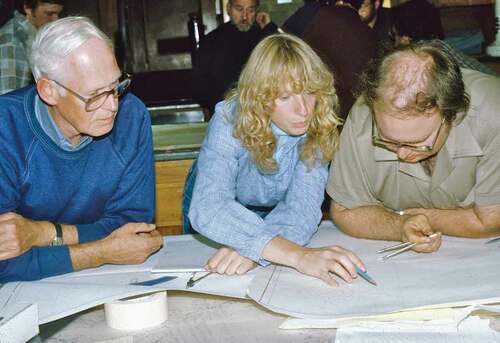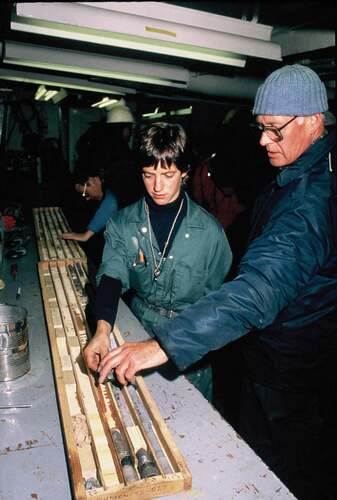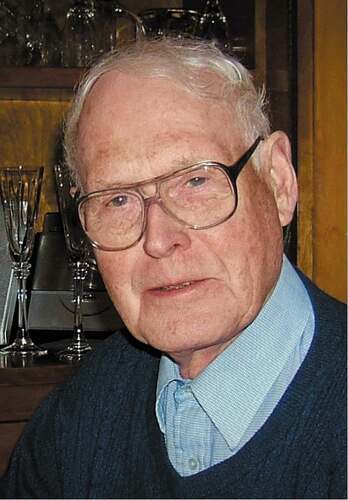With the death of Brian MacLean at age 91, Arctic marine geologists lost a long-time friend and valuable colleague. Brian was the epitome of a “gentle man” who loved his work and was always willing to share his knowledge and experience with colleagues young and old (). Brian’s career as a marine geoscientist began with his move in 1966 to the Atlantic Geoscience Center (AGC) at the Bedford Institute of Oceanography (BIO) in Dartmouth, Nova Scotia, Canada. He partnered with Lew King in the Regional Reconnaissance subdivision at AGC conducting regional seafloor mapping. Over the next decades Brian led numerous research cruises, often aboard the CSS Hudson, to map the surficial sediments and bedrock geology of the eastern Canadian margin and the Canadian High Arctic, using geophysical tools, sediment cores and the BIO bedrock drill, methodically revolutionizing our understanding of the Quaternary history of the Canadian margin. Early on, Brian mentored the young geoscientists, Gordon Fader and Heiner Josenhans, mapping the bedrock and surficial geology of the Scotian Shelf. A classic, highly cited, early publication stemming from this project is “Pockmarks on the Scotian Shelf” by King and MacLean (Citation1970). Fader and Josenhans went on to notable careers of their own carrying on the mapping of the Grand Banks and the Labrador Shelf and Hudson Bay, respectively. With this memorial, John Andrews and I want to acknowledge the profound impact that collaboration with Brian MacLean had on both of our careers at the Institute of Arctic and Alpine Research (INSTAAR) and express our great appreciation for him as a geoscientist, colleague and friend.
INSTAAR’s connection with Brian was established in the late 1970’s when Brian shifted his research focus to the eastern Baffin Island shelf. John Andrews’ quest to reconstruct the history of the Laurentide Ice Sheet and its glacial limits necessitated offshore research; his research path and Brian’s were united by their joint interest in the glacial history and paleoceanography of the Canadian Arctic. Thus began a long friendship and productive collaboration between INSTAAR scientists working on paleoclimate and glacial history and colleagues at what is now the Geological Survey of Canada-Atlantic (GSCA). Brian was instrumental in planning and implementing the cruises that produced exciting new results and insights and that formed a foundation of sediment cores and geophysical data that propelled future research. Brian also became a close friend and colleague to many INSTAAR graduate students and researchers, who were part of the research teams on several CSS Hudson cruises with Brian as the Chief Scientist. Brian’s careful and insightful leadership on these cruises led to fundamental changes in our understanding of both the offshore bedrock geology and the Quaternary history of glaciation, glacier ice extent and deglaciation of major marine channels that funneled fast flowing ice streams into the Labrador Sea and Baffin Bay. For example, Brian’s use of shallow bedrock drilling with the BIO bedrock drill to document Paleozoic carbonate bedrock on the southeast Baffin shelf (MacLean et al. Citation1977; MacLean et al., Citation1986a) and underlying Hudson Strait (MacLean et al. Citation1986b; MacLean Citation2001) established the connections between the Hudson Strait ice stream and North Atlantic Heinrich events.
INSTAAR’s initial turn to offshore research in Arctic Canada is marked by Lisa Osterman’s PhD study of marine sediment cores in Frobisher Bay. Lisa was a student of John’s at INSTAAR/Dept. of Geological Sciences at the University of Colorado and was the first student to receive assistance from Brian. He helped her to access the Frobisher Bay cores originally obtained by Dick Fillon. Then, as fresh INSTAAR post docs, Lisa and Alan Nelson worked on several cores that were collected in cross-shelf troughs on the eastern Baffin shelf by Brian on the CSS Hudson. They published their work on the Holocene foraminiferal and paleoceanographic history of the eastern Baffin Island shelf (Osterman and Nelson Citation1989). In 1982 Brian sailed on CSS Hudson with Jaia Syvitski as the Chief Scientist (Syvitski later became Director of INSTAAR from 1995 to 2007) during the first Sedimentology of Arctic Fiords Experiment (SAFE) cruise. Claudia Currie (then Blakeney), an important GSC colleague and INSTAAR collaborator, was a pivotal member of the SAFE cruises as well (). Claudia became an essential, competent partner for Brian on all of his subsequent cruises and an excellent resource for INSTAAR students. Sediment cores from the two SAFE cruises (1982 and 1983) and from Brian’s previous coring on the eastern Baffin shelf provided the basis for the MS thesis of Anne Jennings and for many research projects at INSTAAR, especially through collaboration with John Andrews. Brian contributed a chapter on the “Geology of the Baffin Island Shelf” (MacLean Citation1985), to the book Quaternary environments. Eastern Canadian Arctic, Baffin Bay, and Western Greenland, edited by John Andrews, presaging the publication of an important study on the Quaternary geology of the Southeast Baffin Shelf (Praeg et al. Citation1986).
Figure 2. Working aboard the CSS Hudson during the 1982 Sedimentology of Arctic Fiords Experiment (SAFE) cruise 8203. From left to right: Brian MacLean, Claudia Currie, Ken Asprey. Photo courtesy of Jaia Syvitski.

Brian led major seismic and coring expeditions into Hudson Strait in 1985 and 1993 that culminated in 2001 in a comprehensive publication about the marine geology of Hudson Strait and Ungava Bay and the Late Quaternary depositional environments and late glacial-deglacial history uncovered by study of the marine sediments, together with correlation to events interpreted from the terrestrial record (MacLean Citation2001). Several graduates and researchers from INSTAAR participated in these cruises or were involved with the subsequent investigation and publications concerning the numerous cores and geophysical data that were obtained (e.g. Barber et al. Citation1999). As an active collaborator with INSTAAR scientists, Brian presented his research at several Arctic Workshop meetings held at the University of Colorado Boulder, and at several universities in Canada, including the 1985 meeting hosted by the Geological Survey of Canada-Atlantic (GSCA) at BIO. CSS Hudson cruise 85027 into Cumberland Sound, which Brian lead and which provided the cores and geophysical data for Anne Jennings’ PhD thesis, resulted in a fundamental re-assessment of the “little ice extent” hypothesis concerning the extent of the Laurentide Ice Sheet. The angular unconformity between Cretaceous bedrock and subglacial till revealed by geophysical surveys and sediment/bedrock cores in Cumberland Sound showed without doubt that the ice sheet had grounded in Cumberland Sound and extended onto the Southeast Baffin Shelf. One of these bedrock samples was taken in an unconventional way. The piston corer was deployed at site 85027–31 with the hope of penetrating the glaciomarine sediments of the Davis Strait Silt and getting a sample of the till of the Baffin Shelf Drift. The piston corer got stuck in the seabed and was so hard to pull out that the Hudson was tipping sideways from the tension on the cable! When the core was pulled up, the core cutter showed black Cretaceous bedrock with bright yellow native sulfur, demonstrating that the angular unconformity between subglacial till and Cretaceous bedrock had been sampled, and that the till above bedrock was full of Cretaceous mudstone ().
Figure 3. Brian MacLean (right) Anne Jennings (left) aboard CSS Hudson, examining a bedrock core taken with the BIO drill during cruise 85027. Photo courtesy of GSC-Atlantic.

Brian led CSS Hudson cruise 86027 into the channels of the Canadian Arctic Archipelago (Lancaster, Wellington, Byam Martin, Barrow Strait), that form important connections between the Arctic Ocean and Baffin Bay, resulting in several publications on the geological and geotechnical results, glacial history and paleoceanography (e.g. MacLean et al. Citation1989). Given the growing importance of reduced Arctic sea ice and the potential for reliable marine transit through the Northwest Passage, this original field work has been followed on by GSC-Atlantic efforts such as CCGS Hudson cruise 2008029 led by Calvin Campbell and Anne de Vernal and CCGS Amundsen cruise 2011804. These cruises led to extensive collaboration with academic colleagues such as Anna Pieńkowski (including her PhD thesis work at the University of Alberta and Mark Furze on the ice-ocean interactions and glacial history in the Northwest Passage (e.g. MacLean et al. Citation2010; Pieńkowski et al. Citation2012). Brian’s excellent paper (MacLean et al. Citation2017) about glacial lineations in Parry Channel exemplifies his 60-year growth as a geoscientist and his consistently thorough and thoughtful interpretations.
Brian loved his work. He received the 40-year service medal from Natural Resources Canada in 1995 and he never stopped working after he retired in 1997. He remained at BIO/GSCA as an emeritus scientist because he loved research and the camaraderie of his coworkers. He was unusually curious, excited to learn more, and was always ready to apply his vast storehouse of knowledge and share it with his colleagues. Brian impacted and benefited many scientists at all stages of their careers through his generous and collaborative approach to research. These words cannot fully capture Brian’s generous and collaborative nature or completely express the gratitude we feel toward Brian for making our research careers so rewarding and possible! Visits to GSC-Atlantic for sampling were always enjoyable: talking with Brian, getting his advice, and invariably having at least one memorable meal in Halifax or Dartmouth. He always remembered his colleagues and never failed to send a Christmas and New Year holiday greeting every year. He will be missed.
Acknowledgments
We thank Carole MacLean, Alan Nelson, Lisa Osterman, David Piper, Patrick Potter, and Jaia Syvitski, among others, for their contribution and information.
References
- Barber, D. C., A. Dyke, C. Hillaire-Marcel, A. E. Jennings, J. T. Andrews, M. W. Kerwin, G. Bilodeau, R. McNeely, J. Southon, M. D. Morehead, et al. 1999. Forcing of the cold event of 8200 years ago by catastrophic drainage of Laurentide lakes. Nature 400 (6742):344–48. doi:https://doi.org/10.1038/22504.
- King, L., and B. MacLean. 1970. Pockmarks on the Scotian Shelf. Geological Society of America Bulletin 81 (10):3141–48. doi:https://doi.org/10.1130/0016-7606(1970)81[3141:POTSS]2.0.CO;2.
- MacLean, B. 1985. Geology of the Baffin Island Shelf. In Quaternary environments: Eastern Canadian Arctic, Baffin Bay, and Western Greenland, ed. J. T. Andrews, 546–57. London: Allen and Unwin.
- MacLean, B. (ed.). 2001. Marine geology of Hudson Strait and Ungava Bay, Eastern Arctic Canada: Late Quaternary sediments, depositional environments, and late glacial-deglacial history derived from marine and terrestrial studies. Natural Resources Canada, Geological Survey of Canada, Bulletin 566:65–69. doi:https://doi.org/10.4095/212200.
- MacLean, B., S. Blasco, R. Bennett, J. England, W. Rainey, J. Hughes-Clarke, and J. Beaudoin. 2010. Ice keel seabed sculpturing in marine channels of the central Canadian Arctic Archipelago: Evidence for former ice streams and iceberg scouring. Quaternary Science Reviews 29 (17–18):2280–301. doi:https://doi.org/10.1016/j.quascirev.2010.05.032.
- MacLean, B., S. Blasco, R. Bennett, T. Lakeman, A. J. Pieńkowski, M. F. A. Furze, J. Hughes Clarke, and E. Patton. 2017. Seafloor features delineate Late Wisconsinan ice stream configurations in eastern Parry Channel, Canadian Arctic Archipelago. Quaternary Science Reviews 160:67–84. doi:https://doi.org/10.1016/j.quascirev.2017.02.001.
- MacLean, B., L. F. Jansa, R. K. F. Falconer, and S. P. Srivastava. 1977. Ordovician strata on the southeastern Baffin Island shelf revealed by shallow drilling. Canadian Journal of Earth Sciences 14 (8):1925–39. doi:https://doi.org/10.1139/e77-163.
- MacLean, B., G. Sonnichsen, G. Vilks, C. Powell, K. Moran, A. Jennings, D. Hodgson, and B. Deonarine. 1989. Marine geological and geotechnical investigations in Wellington, Byam Martin, Austin, and adjacent channels, Canadian Arctic Archipelago. Geological Survey of Canada, Paper 89–11. 1–69.
- MacLean, B., G. L. Williams, A. E. Jennings, and C. Blakeney. 1986a. Bedrock and surficial geology of Cumberland Sound, N.W.T. Current Research, Part B. Geological Survey of Canada, Paper 86-1B. 605–16.
- MacLean, B., G. L. Williams, B. V. Sanford, R. A. Klassen, C. Blakeney, and A. Jennings. 1986b. A reconnaissance study of bedrock and surficial geology of Hudson Strait, N.W.T. Current Research, Part B. Geological Survey of Canada, Paper 86-1B. 617–35.
- Osterman, L. E., and A. R. Nelson. 1989. Latest Quaternary and Holocene paleoceanography of the eastern Baffin Island continental shelf, Canada: Benthic foraminiferal evidence. Canadian Journal of Earth Science 26 (11):2236–48. doi:https://doi.org/10.1139/e89-190.
- Pieńkowski, A. J., J. H. England, M. F. A. Furze, F. Marret, F. Eynaud, G. Vilks, B. Maclean, S. Blasco, and J. D. Scourse. 2012. The deglacial to postglacial marine environments of SE Barrow Strait, Canadian Arctic Archipelago. Boreas 41 (2):141–79. doi:https://doi.org/10.1111/j.1502-3885.2011.00227.x.
- Praeg, D. B., B. MacLean, I. A. Hardy, and P. J. Mudie. 1986. Quaternary geology of the southeast Baffin Island continental shelf. Paper 85–14. Ottawa: Geological Survey of Canada.

